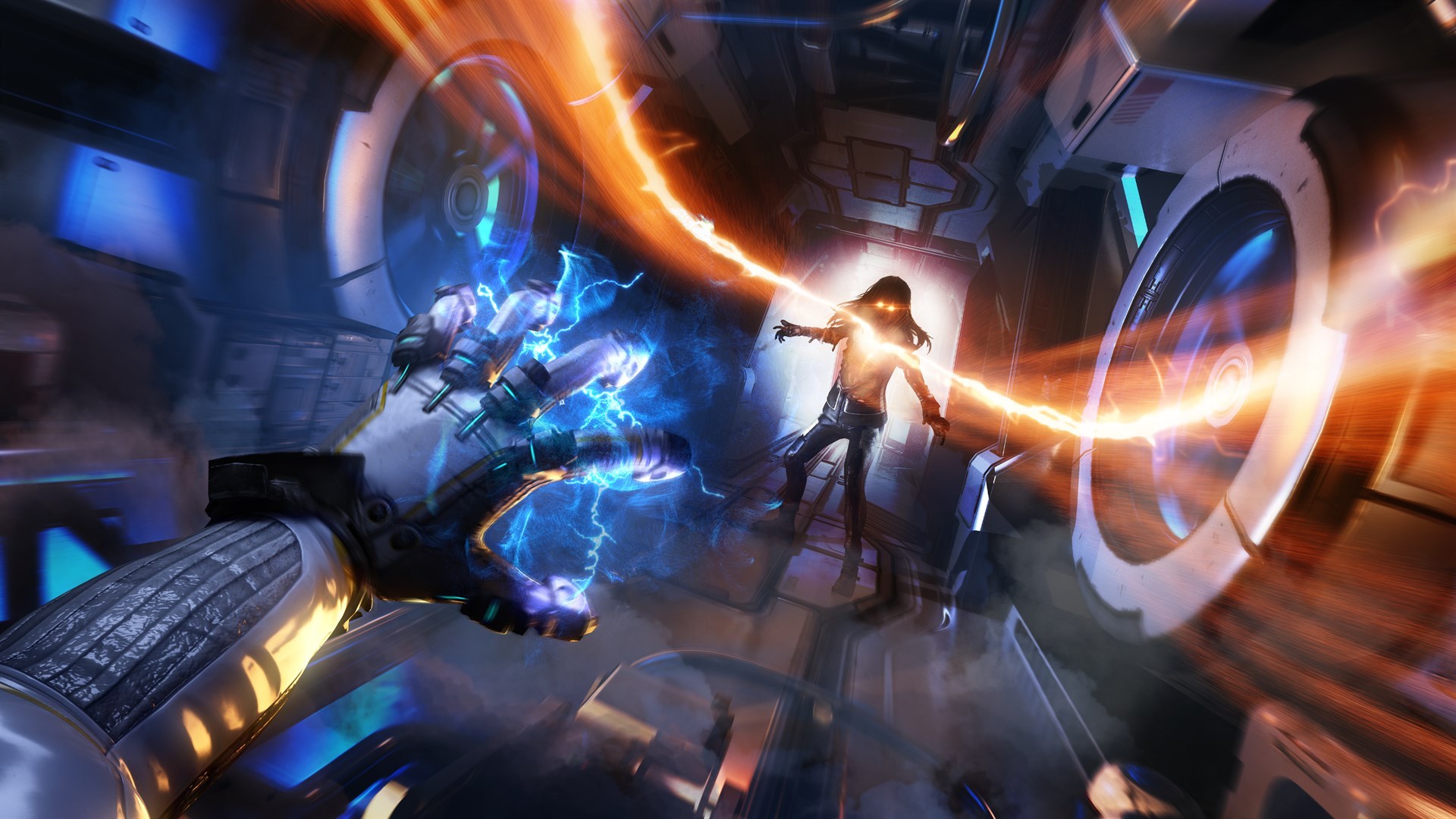They say that in outer space no one can hear you scream. I imagine that was true within the dilapidated halls of The Persistence, a wayward starship that serves as the setting of a horror/roguelike video game of the same name. The Persistence strands players on a ship teeming with exactly the wrong kind of life, after a spacefaring crew winds up massacred, and the only hope for escape is the same glitching organic printing system that’s filling The Persistence’s shifting corridors with a never-ending supply of bloodthirsty mutants. Thanks to that organic printer’s isolated ability to print an unlimited supply of human bodies however, protagonist, Zimri Eder can die as many times as she has to before escaping, making sweet salvation a mere matter of, well, persistence.
If The Persistence sounds vaguely familiar to you, it could be because you’re a VR gaming enthusiast. The game was actually first released in 2018, as a PlayStation VR title. As of this year however, not only can PS4 owners finally play The Persistence without the need to hook up a PS VR headset, but the game has also recently expanded to competing platforms, including those that don’t support VR at all. You still have the option of playing in VR in this year’s belated PC port of The Persistence, if you own a supported VR headset and prefer that method, but even if you’re an Xbox One owner or Nintendo Switch owner without any option to play games in VR, The Persistence’s hair-raising gauntlet has finally opened up to you as of this past Summer. Considering that it’s slim pickings for new console horror games in 2020 as well, the timing couldn’t be better for those eager to seek out a challenging, but potentially rewarding Halloween-friendly gameplay experience.
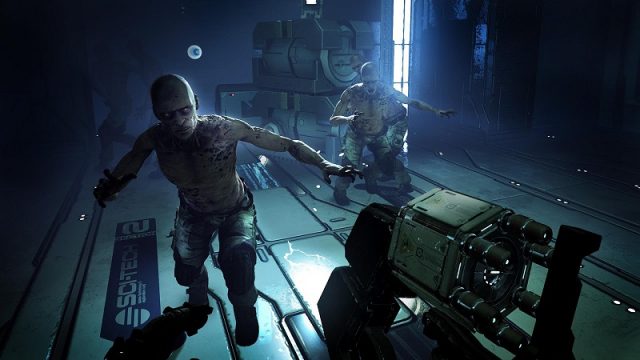
Of course, one should also bear in mind that The Persistence makes clear right from the title that it’s not an easy game. Enemies are merciless, and even slight mistakes will often be quickly punished with a trip straight back to the starting area, especially in the early game! You’re never truly out of options in The Persistence though, and as with any roguelike worth its salt, every run can grant you more resources, more upgrades and more of an ability to strike back at your enemies. The early grind eventually allows you to grow into a hardened, dangerous survivor, one that can leverage their many failures into a deadly set of skills. Before that though, The Persistence demands you fail, a lot, and that demand will no doubt wear on the patience of some players. Nevertheless, if you can stick it out, The Persistence can be quite rewarding to conquer, even if its post-game content certainly leaves a lot to be desired.
Developer, Firesprite Games has done a pretty solid job of re-tooling the visual suite of The Persistence to no longer be dependent on a VR display. You can certainly tell that the game’s roots are in VR, between some menus that inexplicably move, and some eye-friendly, highly polygonal particle effects, but when played on a television or monitor, The Persistence does look competently presented. The Persistence itself looks adequate, containing a decent amount of texture detail, though the monster designs definitely flex a bit more graphical muscle, having bulbous sores and deformed flesh that manages to feel nicely unnerving. Environmental effects, by contrast, feel noticeably ill-defined however, which may disappoint those looking for a more carnage-filled trek through the ruins of this spaceship. This is no doubt another visual concession made for VR, but now that The Persistence doesn’t need to be played in VR anymore, these less impressive environmental flourishes stick out more than they used to.
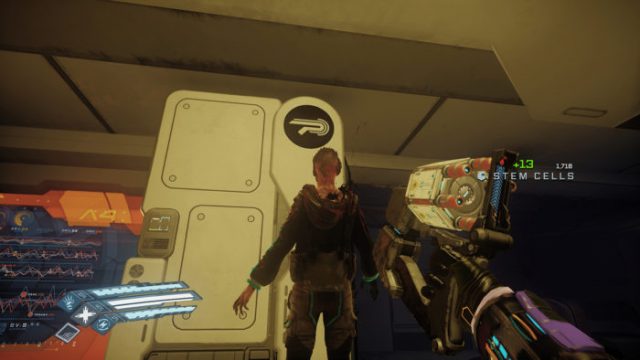
Fortunately, in giving players the option of ditching PS VR for the first time this year, The Persistence now boasts several graphical enhancements that it didn’t offer before. Even though some of its visual touches still feel like they’re holding back for VR headsets that players no longer need, the fact that The Persistence boasts a rock-solid 60fps performance clip even on a base model PS4 or Xbox One is pretty impressive! The Nintendo Switch version isn’t quite so stacked, since its performance only runs at a reduced 30fps, both docked and undocked, but the Switch version is nonetheless one of the most visually ambitious builds of The Persistence. It sports a variable resolution rate that keeps performance at a steady 30fps at all times, and otherwise strives for a target of 1080p resolution while docked, and 720p resolution while undocked, a target it hits on both counts more often than not.
Those with premium hardware have the option of pushing the visuals further, though PC gamers might want to keep their expectations in check. The Persistence looks pretty good on maximized PC settings, and can be pushed well above 1080p if your computer can support it, but the visual and performance options are fairly limited, offering boilerplate presets that don’t manage to stand out. This is a little head-scratching, especially considering The Persistence’s surprisingly robust recommended system requirements. Playing the PC version in VR doesn’t present much more visual flexibility either, nor does it manage to elevate the experience above how it’s otherwise presented on PS VR. That said, both PS4 Pro and Xbox One X allow you to play The Persistence in 4K resolution (assuming you’re not playing the PS4 Pro build in VR, obviously), without compromising the 60fps performance clip, leaving the game in the interesting position of feeling like it’s more technically impressive on consoles than it is on PC.
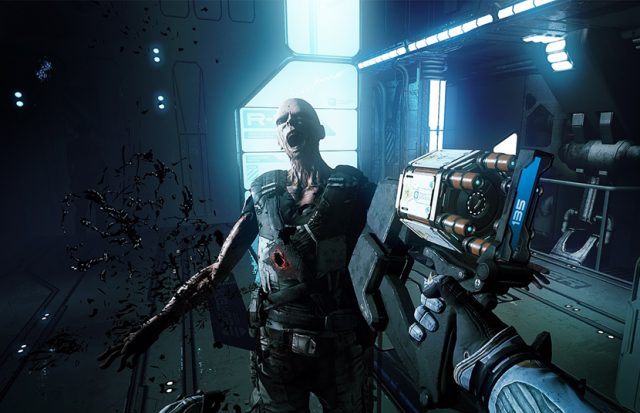
The visual suite throughout The Persistence nonetheless feels like it’s a cut above many other indie games though, regardless of which platform you play it on. Even with some of the missed opportunities in tailoring the experience more to PC, both in VR and non-VR gameplay, The Persistence feels atmospheric, haunting and genuinely suspenseful. The ability to play in 4K on PS4 Pro and Xbox One X also excellently compensates for the removal of VR, even if there is a bit of immersion lost when you play on a regular display, versus a VR headset. Whether you prefer VR or non-VR however, the atmosphere and hair-raising tone behind The Persistence is on point, creating a game that’s easy to get lost in, without even one framerate chug to blame when you end up being blindsided by a mutant.
Where The Persistence tends to impress most is in its audio, something that’s to be expected from a game aspiring to be a horror experience. This is a game that definitely demands to be played with a good pair of headphones. Subtle creaks and groans can constantly be heard as you skulk around The Persistence’s halls, with the occasional jump scare spliced in, as a vent suddenly hangs loose, or a cracked pipe spews non-damaging exhaust in your vicinity. This game’s ambiance definitely does a great job of putting you on edge! The ship itself feels like it could come apart at any moment, while at the same time containing vicious threats that feel like they could strike anywhere, anytime.
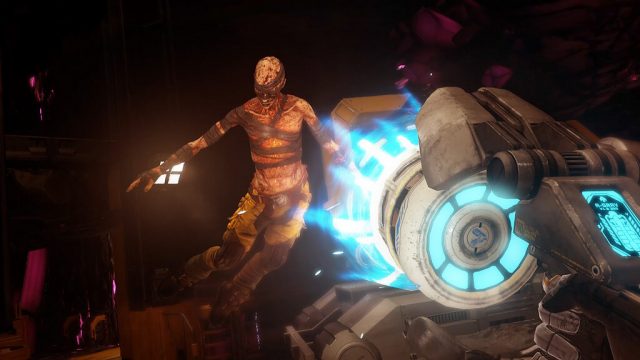
The small amount of music and voice acting in The Persistence is also pretty good overall, though the vast majority of the gameplay experience is devoid of both. Instead, the cries of mutants, the sliding of doors, and the whirring and buzzing of your tools and weaponry keep the audio engagement going on their own. This feels appropriate, because interpreting audio cues can be crucial to surviving in The Persistence. You’ll need to pay attention to the sharp buzzing of a depleted shield, the proximity of raging enemies barreling towards you, and the telltale surge of a booby-trapped floor or wall panel (something that’s thankfully also communicated through a small controller rumble!), which gives you a couple of seconds to step away or risk getting hurt!
This audio suite is definitely designed for a pair of headphones, and that’s unsurprising in a game that was originally made to be played in VR. Even playing with built-in TV speakers or auxiliary speakers however, The Persistence is skilled at instilling a sense of dread in the player, one that eventually gives way to an odd sense of comfort as your skills and resources improve. The sounds of the ship and its monsters almost feel like crucial characters in and of themselves, and mastering their rhythm is one of the keys to surviving and prevailing amid the many hazards of The Persistence.
The Persistence may call back to terrifying, space-bound scarefests like Dead Space, but its actual gameplay progression has a lot more in common with Dead Cells. As the ‘backed up’ consciousness of surviving crew member, Zimri Eder, you’ll have to make use of a supply of clone bodies in order to outlast a deadly onslaught of mutants that have infested your spaceship, The Persistence. These mutants also happen to be wandering all throughout the corridors leading to crucial ship components such as the warp engine and jump bearings. Zimri will thus need to brave the endless, respawning horrors of the ship in order to fiddle with enough machines so that she can eventually escape, alongside the A.I. consciousness of another crewmate, engineer, Serena Karim, who helps give you step-by-step instructions regarding how to escape your predicament.
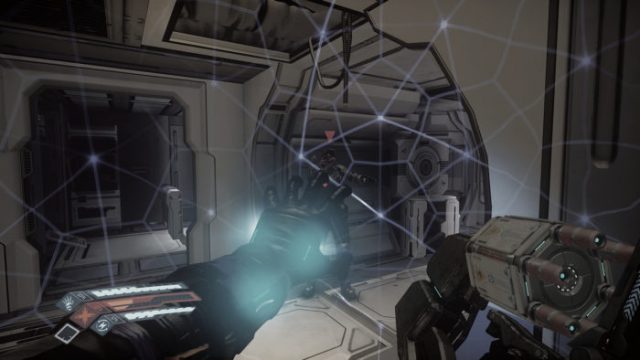
It wouldn’t be a roguelike without procedural generation though. Sure enough, navigating The Persistence is anything but straightforward! Among the malfunctioning defenses is a protocol that constantly changes the layout of each of the ship’s four decks, creating a labyrinthine gauntlet that never appears the same way twice. Paths, enemies, items, collectibles, objectives, all of it is located somewhere different every time you enter and re-enter a deck, necessitating that you always stay alert! Fortunately, even with its ever-shifting corridors, The Persistence is also littered with maps that help guide you to where you want to go, which you can also pull up at will with a tap of one of the input buttons, or the touch pad if you’re playing on PS4. Thus, even if you won’t initially know where you’re going, it’s also impossible to truly get lost as you attempt each run throughout the ship.
Despite the ease of getting your bearings however, enemies can still cut your run short very quickly. Every time you first enter a new deck, you’ll be easy prey for the mutants around you, who can take you out in just a couple of hits early on! Death will send you back to the “Recovery” area to select a new clone, with each potential clone body granting a passive benefit unique to it, including higher loot percentages, better melee damage, more health, etc.. You can further outfit these clone bodies by securing FAB Chips and Schematics as well, with the former being randomly littered across each deck or dropped by enemies, while the latter are occasionally dropped by enemies, but are most often found from ‘Supply Chests’, which are usually guarded by environmental hazards or a herd of mutants.
One small mercy that The Persistence grants you is that you don’t ever lose your spoils from dying, at least beyond having to spawn a new clone body. That’s good, because The Persistence will kick your ass while you’re learning how to properly play it! This game isn’t really complicated, but its initial difficulty curve is quite steep, resulting in some frustration early on. There’s a good amount of trial-and-error that comes from navigating each new deck, and each new threat upon it, potentially making The Persistence an uphill climb for impatient players. The fact that you can keep everything you’ve found upon death at least allows you to chip your way to gradually better stats and equipment, but it can take a couple of hours, at minimum, to feel like you have a handle on how to progress in The Persistence, despite how otherwise simple its gameplay is.
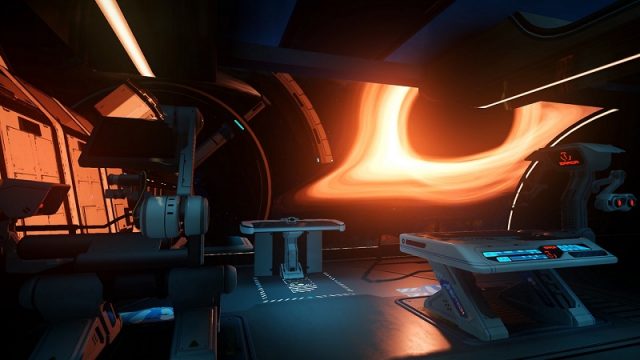
Even so, The Persistence is far from rigid. Whenever you’re booted back to Recovery, you have the option of using whatever Schematics you found on your prior runs to craft new, better equipment for your player character. Schematics come in varying degrees of usefulness, ranging in increasing value from Common to Uncommon to Rare to Epic. When you spend FAB Chips to develop a Schematic, you can equip your clone body with armaments that cater to your play style, prioritizing what’s most important to you, especially in regards to which suits you can craft. Whether you want to emphasize aggression, defense, stealth, health management, or multiplying your loot, you can always do so if you’re willing to pony up the FAB Chips, and hunt down related Schematics. This is of course based on RNG mechanics to some degree though, since loot is randomized, and that includes Schematics that you can potentially find. Still, if you’re willing to grind your way through dangerous enemies, you can eventually assemble a loadout that lets you approach decks with whatever priorities you have in mind, even if you must always be mindful of the mutants in your midst.
So, if mutants are so dangerous and damaging then, how exactly do you take them out? Well, you can do so with weapons, of course, which can be built from Fabricators using FAB Chips at random points throughout each deck, while another consumable called ‘Erebus Tokens’ allows you to permanently upgrade fabricated weapons’ capacity. Some of these weapons include guns with a small amount of bullets, though other Fabricators can make you melee weapons, while yet more Fabricators can build you grenades, or other specialty tools that you can use to control the battlefield. Some of the highlights among this specialized equipment include an escape remote that randomly teleports you to somewhere else on the deck, a time warp that can temporarily slow down enemies, or some serums that can either make you temporarily stronger and invulnerable, or coerce an enemy to fight for you against its brethren.
There are an impressive amount of options through which to navigate The Persistence’s challenges, even if your character’s movement is predictably pretty sluggish. Horror game rules and all. Still, you can at least compensate for this with the ability to teleport a short distance using one of the face buttons, a la Dishonored. This trick costs ‘Dark Matter Energy’ to use though, a rechargeable meter that prevents you from spamming your teleporting, along with your ability to briefly sense enemy placement, something controlled by another face button. Sensing and teleporting is not only useful for creeping around enemies, but also sneaking up on them. You see, rather than a conventional ‘stealth kill’ option, The Persistence allows you to harvest ‘Stem Cells’ from enemies, by moving behind them and tapping the appropriate face button. Stem Cells are not just used to regenerate specialized clone bodies as well. They can also be used to permanently increase your base stats, including maximum health, melee damage, Dark Matter regeneration, and how stealthy you can be while moving/crouching. You can find Stem Cells randomly lying around each deck, a la FAB Chips, but the best way to get them is to rip them from unsuspecting enemies, further rewarding your efforts to avoid directly picking fights as much as possible.
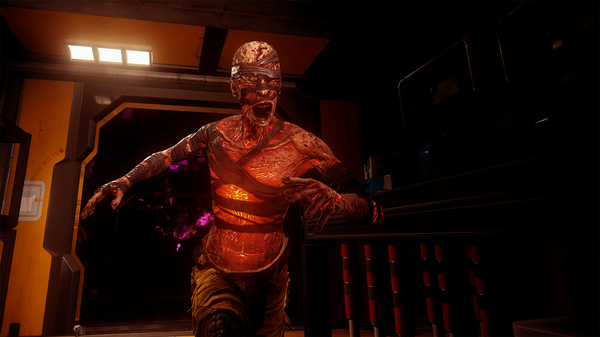
Naturally, different enemy varieties require different strategies as well, and some are naturally easier to harvest from than others. While basic engineers and lurkers will simply charge you, and can be snuck up on or staggered with your shield fairly simply, the hulking Berserkers, which are very strong and durable, long-range Weepers, who teleport around and assault you with highly damaging beams, kamikaze Fireballs, which charge at you and explode, and relentless Listeners, who hear your movement and fire bullets at you, are much more difficult, if not impossible to destroy without engaging them the old-fashioned way. These enemy varieties will be very daunting at first, especially considering the heavy amount of damage they can do before you’re adequately powered up, but once you’ve figured out each enemy’s strategy, you can defeat them without much thought. The enemies in The Persistence may be powerful, but they’re also witless, and that’s something that the player can often use to their advantage.
This is why it’s easy to wish that The Persistence’s threats were a little more varied and unpredictable in the later segments of the game. Once you become wise to the tricks and traps of The Persistence, you’ll have enough ingenuity and abilities to anticipate where threats will come from, especially when they’re not often capable of truly ‘hiding’. Sure, Weepers can snipe you with their deadly energy beams, and Lurkers will occasionally surprise you from a corner, but even these trickier enemies become old hat before long. When being overwhelmed by enemies is a bigger problem than being surprised by them, the jump scares and atmospheric touches have to do most of the heavy lifting throughout The Persistence’s horror, even if those little touches are undeniably impressive on their own.
Another issue working against the lasting appeal of The Persistence is the fact that it’s post-game content is disappointingly scant. You can unlock a Survival Mode that tasks you with playing through the game with only ten lives, and a Campaign+ Mode that makes enemies stronger and smarter, though also lets you carry over upgrades and resources from a previous playthrough. These new campaign modes are just the same experience again though, only now with the difficulty cranked up. Likewise, there’s also a Challenge Mode that allows you to try for special objectives, such as shooting through a horde of enemies without the ability to survive a hit, or having to sneak around enemies armed with only a knife… Along with the inability to survive a hit. Again, this is a riff on the same idea, and it’s not compelling content. You’ll probably play through the main campaign of The Persistence in about 5-6 hours, and by then, you’ll have pretty much seen every obstacle the game can throw at you. After that, the only thing that could potentially keep calling you back are the admittedly fun, engaging achievements/trophies on offer, and that’s not even an option if you’re playing the Switch version.
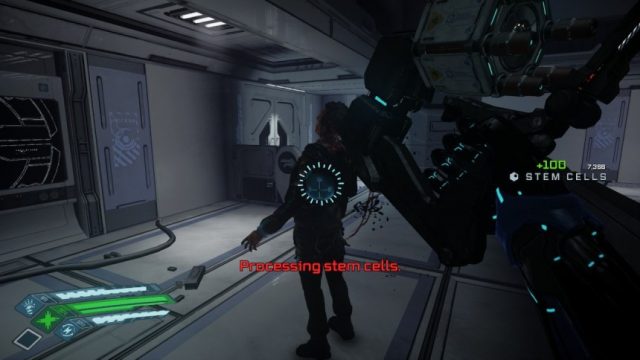
On the flip side though, if you’re really struggling with The Persistence, it does allow you to play in ‘Assist Mode’, thereby weakening enemies, giving you unlimited Dark Matter energy, and other benefits. This is appreciated, since it allows you to see the entirety of the game, even if you find that you’re getting impatient with it. Strangely though, once Assist Mode is enabled, you can’t turn it off without starting a new game, possibly to prevent players from cheesing the main gameplay progression. Likewise, achievements/trophies are completely disabled when you turn on Assist Mode, though this is moot if you’re playing on Switch, a platform that lacks an achievement system. Once again, it’s nice that The Persistence is so flexible, but it sucks that the intrigue tends to run out once you’ve finished the campaign.
Even if the over-arching horror sees a sense of diminishing returns later on however, there is a sweet spot wherein you get into a groove about halfway through campaign progression, and then start feeling more empowered to succeed, while still respecting the dangers that lie around every corner. If you’re a fan of roguelikes especially, The Persistence can be quite gripping once you reach a certain point of progression. Achievement/trophy hunters will be especially pleased, since earning Gamerscore or striving for a Platinum is often where The Persistence becomes most creative in challenging players. The overall gameplay experience still holds up plenty well without VR to boot, though this also means that The Persistence can’t merely be judged as a VR game anymore. In that sense, it’s still fun on platforms beyond PS VR, but as a non-VR game especially, The Persistence definitely deserved to go a little further with some of its stronger early ideas.
The Persistence is a good roguelike and a solid horror game, with or without VR. Its ports beyond PS VR also prove to be quite competent, at least beyond the slightly disappointing PC port. That said, while the game’s tension and atmosphere is quite strong, there is a point where it descends into repetition, and essentially runs out of steam. The post-game is where this is most apparent, as players are presented with a paltry degree of shallow options to keep the challenge going. Hours before that as well, a percentage of players will probably be frustrated by the questionably balanced early portion of The Persistence, which is rife with highly damaging enemies, and pathetically useless stats and equipment. This all combines to make The Persistence’s $29.99 USD price feel rather steep, especially when it can no longer lean on the excuse of being a PS VR-exclusive experience.
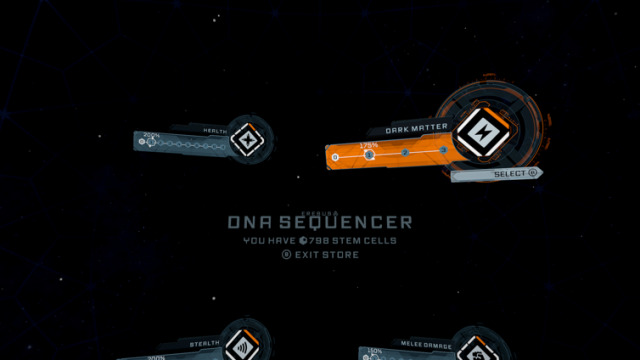
Despite its flaws however, I did have fun with The Persistence during my six hours or so playing through the main campaign. This is a game that definitely demands a certain kind of player, specifically a very patient one, but that patience can be rewarded if you stick out that stiff early stretch. I definitely wish there was more to do after the credits roll, but once you make it to the lower decks of the ship, the challenge becomes intoxicating. Even the Edge of Tomorrow-esque loop of live, die, repeat, the backbone of the roguelike subgenre, can become strangely motivating, once you’ve come to believe that you will succeed, no matter how many times you must be resurrected.
If you’re interested in The Persistence, I would definitely wait for it to go on sale before buying it. Regardless, for those who enjoy roguelikes and/or horror games, The Persistence can scratch both of those itches pretty well, if you’re up for the challenge, and can look past some of the rough edges. It’s certainly not the next Dead Space, but The Persistence is nonetheless good enough to not truly need VR to sustain its appeal.
This review is based on an Xbox One copy of, “The Persistence”, provided by publisher, Firesprite Limited.

